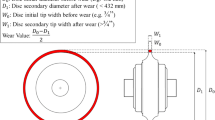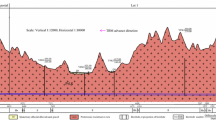Abstract
Disc cutters are the dominant cutting tools used in tunneling by rock TBMs. During the operation, disc cutters wear out and should be replaced with new ones. The wear rate of the disc cutters can be defined in terms of rolling distance/time and volumetric wear. Furthermore, the wear rate can be attributed to the mass loss. The wear prediction models for disc cutter have been developed on the basis of the intact rock abrasion indices, most commonly Cerchar abrasivity index (CAI). Examination of these models and comparing their results with actual wear observed in the Kerman water conveyance tunnel (KWCT) project show that the available models are conservative. In other words, reliance only on the intact rock abrasion does not offer an accurate prediction of the wear rate of the disc cutter. Therefore, rock mass conditions should also be considered in the calculations. The current study shows that volumetric mass loss is a more appropriate method to predict wear life of disc cutters due to consideration of various geometric parameters such as spacing between disc cutters, penetration rate, installation radius, and bored length. Subsequently, a new empirical prediction model is proposed by nonlinear multivariable regression based on CAI as a rock material parameter and RQD (rock quality designation) as a rock mass parameter to estimate the cumulative volumetric mass loss of disc cutters. For ease of using the model, a chart is introduced that determines the wear on the disc cutters based on the CAI and RQD.


















Similar content being viewed by others
Abbreviations
- A, B :
-
Correlation coefficient
- CAI :
-
Cerchar abrasivity index
- D :
-
Primary diameter of the disc cutter (before wear process)
- D ′ :
-
Secondary diameter of the disc cutter (after wear process)
- F :
-
Function
- f :
-
Mass loss function
- L :
-
TBM advance length
- l :
-
Length of the rolling path of the disc cutter over the tunnel face per one revolution
- MR:
-
Rolling mass loss due to one rotation over the tunnel face
- \( \overline{\mathrm{MR}} \) :
-
Weighted average of rolling mass loss
- MV:
-
Volumetric mass loss due to boring of a certain volume of rock
- \( \overline{\mathrm{MV}} \) :
-
Weighted average of volumetric mass loss
- n :
-
Number of disc cutters in a disc group
- P :
-
Depth or penetration rate of the disc cutter into the tunnel face per revolution
- \( \overline{R} \) :
-
Mean installation radius in a disc group
- R :
-
Installation radius of the disc cutter on the cutterhead
- RQD:
-
Rock quality designation
- S :
-
Impact width of disc cutter
- TL :
-
Tip loss of disc cutter recorded by a measuring template
- V :
-
Specific cutter ring wear in g per volume of excavated rock
- V rock :
-
Volume of excavated rock
- Vs:
-
Specific cutter ring wear in mg per roll meter
- WR:
-
Rolling wear rate of disc cutter
- WV:
-
Volumetric wear rate of disc cutter
References
Aghanabati A (2004) Geology of Iran. Ministry of Industry and Mines, Geological Survey of Iran, 582 p
Alber M (2008) Stress dependency of the Cerchar abrasivity index (CAI) and its effects on wear of selected rock cutting tools. Tunn Undergr Space Technol 23:351–359
Bruland A (1998) Hard rock tunnel boring. Dissertation, Norwegian university of Science and Technology (NTNU)
Deere DU, Miller RP (1966) Engineering classification and index properties for intact rock. Illinois Univ At Urbana Dept Of Civil Engineering
Ellecosta P, Kasling H, Thuro K (2018) Tool wear in TBM hard rock drilling - backgrounds and special phenomena. Geomech Tunnel 11:142–148
Espallargas N, Jakobsen PD, Langmaack L, Macias FJ (2015) Influence of corrosion on the abrasion of cutter steels used in TBM tunnelling. Rock Mech Rock Eng 48(1):261–275
Farrokh E, Kim DY (2018) A discussion on hard rock TBM cutter wear and cutterhead intervention interval length evaluation. Tunn Undergr Space Technol 81:336–357
Frenzel C (2012) Modeling uncertainty in cutter wear prediction for tunnel boring machines. GeoCongress 2012
Frenzel C, Käsling H, Thuro K (2008) Factors influencing disc cutter wear. Geomechanics and Tunnelling 1:55–60
Gang L, Lida Z, Jianyu Y, Wanshan W (2014) A method to predict disc cutter wear extent for hard rock TBM based on CSM model. Chin Mech Eng 1:7
Gehring K (1995) Prognosis of advance rates and wear for underground mechanized excavations (in German). Felsbau 13(6):439–448
Ghasemi E, Yagiz S, Ataei M (2014) Predicting penetration rate of hard rock tunnel boring machine using fuzzy logic. Bull Eng Geol Environ 73(1):23–35
Gong QM, Yin LJ, She QR (2013) TBM tunneling in marble rock masses with high in situ stress and large groundwater inflow: a case study in China. Bull Eng Geol Environ 72(2):163–172
Hassanpour J (2018) Development of an empirical model to estimate disc cutter wear for sedimentary and low to medium grade metamorphic rocks. Tunn Undergr Space Technol 75:90–99
Hassanpour J, Rostami J, Tarigh Azali S, Zhao J (2014) Introduction of an empirical TBM cutter wear prediction model for pyroclastic and mafic igneous rocks; a case history of Karaj water conveyance tunnel, Iran. Tunneling and Underground Space Technology 43:222–231
Hassanpour J, Rostami J, Zhao J, Tarigh Azali S (2015) TBM performance and disc cutter wear prediction based on ten years experience of TBM tunnelling in Iran. Geomechanics and Tunnelling 8:3
Houmei Z (2006) Study on numerical simulations of performance of tunnel boring machines (TBM). Tunnel Construction 26:117
Kim DY, Farrokh E, Jung JH, Lee JW, Jee SH (2017) Development of a new test method for the prediction of TBM disc cutters life. J of Korean Tunn Undergr Sp Assoc 19:475–488. https://doi.org/10.9711/KTAJ.2017.19.3.475
Koopialipoor M, Nikouei SS, Marto A, Fahimifar A, Armaghani DJ, Mohamad ET (2019) Predicting tunnel boring machine performance through a new model based on the group method of data handling. Bull Eng Geol Environ 78(5):3799–3813
Labra C, Rojek J, Onate E (2017) Discrete/finite element modelling of rock cutting with a TBM disc cutter. Rock Mech Rock Eng 50(3):621–638
Li X, Su X (2009) Forecast of the wear of shield's disc cutters based on multivariate nonlinear regression. Journal of Liaoning Technical University 28:281–283
Lin L, Xia Y, Mao Q, Zhang X (2018) Experimental study on wear behaviors of TBM disc cutter ring in hard rock conditions. Tribol Trans 61(5):920–929
Lislerud A (1997) Principles of mechanical excavation. Posiva Oy. Macias, F. J., Dahl, F., & Bruland, A., 2016. New rock abrasivity test method for tool life assessments on hard rock tunnel boring: the rolling indentation abrasion test (RIAT). Rock Mech Rock Eng 49:1679–1693
Macias FJ, Dahl F, Bruland A (2016) New rock abrasivity test method for tool life assessments on hard rock tunnel boring: the rolling indentation abrasion test (RIAT). Rock Mech Rock Eng 49:1679–1693
Macias FJ, Nærland J, Espallargas N (2018) Cutter wear mechanisms in hard rock tunnel boring. Geomechanics and Tunnelling 11. https://doi.org/10.1002/geot.201800003
Maidl B, Schmid L, Ritz W, Herrenknecht M (2001) Hard rock tunnel boring machines. Ernst & Sohn
Majeed Y, Abu Bakar MZ, Butt IA (2019) Abrasivity evaluation for wear prediction of button drill bits using geotechnical rock properties. Bull Eng Geol Environ:1–21
Naghadehi MZ, Ramezanzadeh A (2017) Models for estimation of TBM performance in granitic and mica gneiss hard rocks in a hydropower tunnel. Bull Eng Geol Environ 76(4):1627–1641
Oparin VN, Tanaino AS (2015) A new method to test rock abrasiveness based on physico-mechanical and structural properties of rocks. J Rock Mech Geotech Eng 7:250–255
Petrica M, Badisch E, Peinsitt T (2013) Abrasive wear mechanisms and their relation to rock properties. Wear 308:86–94
Plinninger R, Alber M, Düllmann J (2018) Rock mass-scale factors with an influence on tool wear in the mechanised tunnelling process in hard rock. Geomech Tunnel. https://doi.org/10.1002/geot.201700068
Rauch R, Goliasch R, Käsling H, Thuro K (2018) Does the in-situ stress state have an effect on tool wear in deep TBM tunnelling? Geomechanics and Tunnelling 11. https://doi.org/10.1002/geot.201800001
Ren DJ, Shen SL, Arulrajah A, Cheng WC (2018a) Prediction model of TBM disc cutter wear during tunnelling in heterogeneous ground. Rock Mech Rock Eng 51(11):3599–3611
Ren D, Shen J, Chai J, Zhou A (2018b) Analysis of disc cutter failure in shield tunnelling using 3D circular cutting theory. Eng Fail Anal. https://doi.org/10.1016/j.engfailanal.2018.02.015
Rostami J, Ozdemir L, Bruland A, Dahl F (2005) Review of issues related to Cerchar abrasivity testing and their implications on geotechnical investigations and cutter cost estimates. Proceedings of the RETC, 738–751
Wang L, Kang Y, Cai ZC, Zhang Q, Zhao Y, Zhao H, Su P (2012) The energy method to predict disc cutter wear extent for hard rock TBMs. Tunn Undergr Space Technol 28:183–191
Wang L, Li H, Zhao X, Zhang Q (2017) Development of a prediction model for the wear evolution of disc cutters on rock TBM cutterhead. Tunn Undergr Space Technol 67:147–157
Wijk G (1992) A model of tunnel boring machine performance. Geotech Geol Eng 10:19–40
Yang H, Wang H, Zhou X (2016) Analysis on the rock–cutter interaction mechanism during the TBM tunneling process. Rock Mech Rock Eng 49(3):1073–1090
Yang Y, Hong K, Sun Z, Chen K, Li F, Zhou J, Zhang B (2018) The derivation and validation of tbm disc cutter wear prediction model. Geotech Geol Eng 36:3391–3398
Zare S, Bruland A (2013) Applications of NTNU/SINTEF drillability indices in hard rock tunneling. Rock Mech Rock Eng 46(1):179–187
Zhaohuang Z (2007) Study on the abrasion of disc cutters on full face rock tunnel boring machine. Mod Tunn Technol 6
Acknowledgments
The authors would like to express their sincere thanks to the assistance of the project manager and personnel of the Kerman water conveyance tunnel project for sharing the actual data of this project.
Author information
Authors and Affiliations
Corresponding author
Ethics declarations
Conflict of interest
The authors declare that they have no conflict of interest.
Rights and permissions
About this article
Cite this article
Karami, M., Zare, S. & Rostami, J. Tracking of disc cutter wear in TBM tunneling: a case study of Kerman water conveyance tunnel. Bull Eng Geol Environ 80, 201–219 (2021). https://doi.org/10.1007/s10064-020-01931-7
Received:
Accepted:
Published:
Issue Date:
DOI: https://doi.org/10.1007/s10064-020-01931-7




